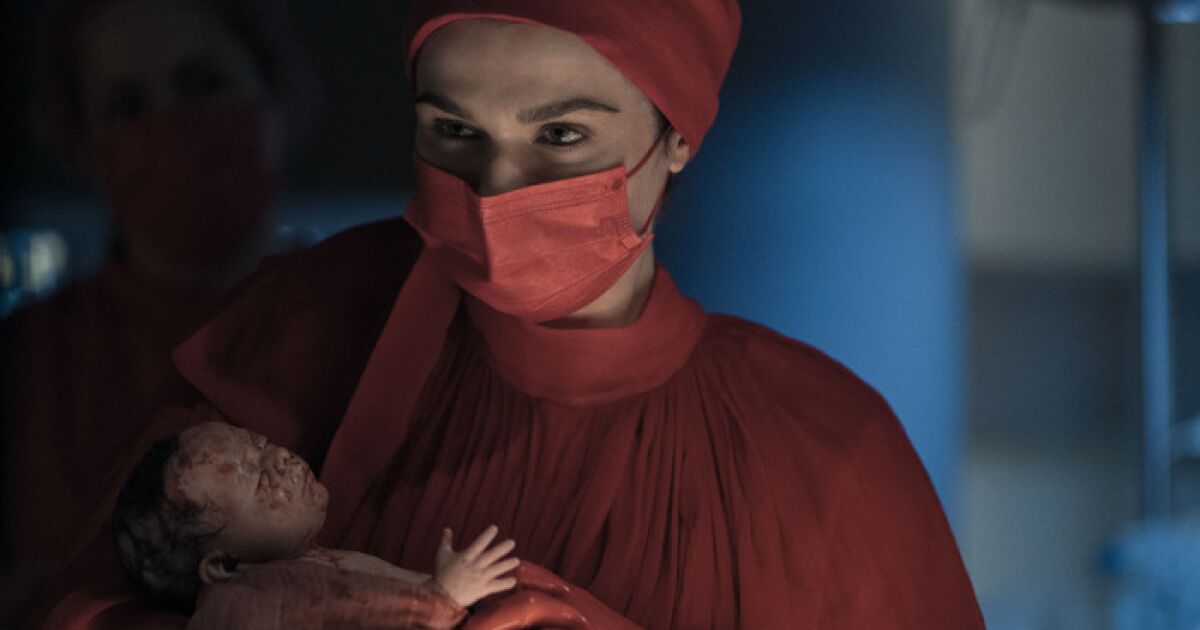
Giving birth in the United States is diabolical. Or at least it is according to Beverly Mantle, one of two identical-twin OB-GYNs played by Rachel Weisz in the Prime Video miniseries “Dead Ringers.”
A gender-switched remake of David Cronenberg’s 1988 thriller, the drama is an unsettling exploration of the codependent relationship between Beverly and her twin sister, Elliot, Manhattan physicians who practice medicine — and do just about everything else — together, but who come to realize their approaches to life and work may be incompatible.
Beverly — the reserved, compassionate one who wears her hair back — wants to “change the way women birth, forever” by opening a revolutionary birthing center. Elliot is an impulsive, hair-down type, who is more excited about pushing scientific and ethical boundaries with a cutting-edge embryology lab than about providing compassionate care.
Created by acclaimed playwright and showrunner Alice Birch, and anchored by a riveting dual performance by Weisz, the series maintains the surreal, uncanny tone of the original film, which starred a deliciously sinister Jeremy Irons.
But expanded to six hours and told from a decidedly feminine perspective, “Dead Ringers” also offers an unusually clear-eyed look at reproductive healthcare in the United States — from the agony of infertility and pregnancy loss to the everyday perils of childbirth, particularly for women of color.
And it wastes no time in doing so: Minutes into the pilot episode, Beverly, who has been trying unsuccessfully to have a baby, scoops bloody tissue out of the toilet after experiencing yet another miscarriage. Soon after, in a visceral montage, she and Elliot do their thing — using forceps, scalpels, suction devices and all manner of verbal coaxing to deliver babies vaginally and via C-section, all the while blood splattering their shoes. Elsewhere, the show grapples with such fraught issues as the regulation of embryos grown outside the womb, the racist origins of modern gynecology, surrogacy and the influence of wealthy benefactors on medical research.
“We knew we wanted it to begin in a really grounded place,” said Birch in a joint phone conversation with Weisz, who played a hands-on role as an executive producer on the series. “The twins are so ambitious, and they have these very clear ideas about how to make things better, that I felt like I needed to make the case for imagining something different. We wanted the births to feel real and for those patients to feel like real women who walk in and out of clinics today.”
Strict realism and preachy didacticism are not the goals of this highly stylized remake (in a nod to the original, the doctors and nurses wear crimson scrubs), but in order for the story to work — and for both Beverly and Elliot’s competing visions to resonate as powerfully as they do — the medicine needed to be anchored in truth. “Dead Ringers” is one of a growing number of TV shows, including “This Is Going to Hurt” and “I Hate Suzie Too,” that resist the squeamishness that so often hampers depictions of women’s bodies to portray reproductive health with a radical form of candor.
“Women’s bodies have been politicized forever,” Birch said. “So I think the show would have felt timely whenever it was coming out.”
Still, at a moment when maternal mortality rates are rising along with restrictions on people’s ability to control when and if they become parents now that Roe vs. Wade has been overturned, Beverly’s tirade about the “f—” system that “bullies and scares and terrorizes and humiliates and ruins women and their bodies” is likely to strike many viewers as the least hyperbolic aspect of the entire series.
A fan of the Cronenberg film since she first saw it as a teenager, Weisz was intrigued by the “twisted, bizarre, codependent relationship” at its center, she said — one that could easily be switched and turned into two rich characters for her to portray: “There seemed to be no reason why one couldn’t have two female identical twins.”
The actor brought the idea for a remake to Annapurna Pictures and suggested Birch, whose TV credits include “Succession” and “Normal People,” to shepherd the adaptation.
Birch was excited about opening up the story by delving further into the twins’ work in obstetrics. In an early conversation with Weisz, Birch recalled a doctor who’d talked about choosing when life begins when they performed C-sections and described themselves in godlike fashion. “It seemed like that might be something that our twins would say,” she said.
The writers room, which consisted of seven women (including Weisz), became a venue for sharing stories about giving birth, visiting the gynecologist and other personal experiences that are now “part of the archaeological layers in the DNA of the whole project,” said Weisz.
The writers used Beverly and Elliot’s competing personalities to explore divergent approaches to women’s health. Beverly believes that pregnancy should be treated as a normal physical condition, not a disease — a philosophical descendant of Ina May Gaskin, the pioneering American midwife (even if her birthing center is much fancier than Gaskin’s famous Tennessee farm). Elliot, meanwhile, just wants a lab where she can play the role of maverick scientist and violate accepted norms with impunity, as she is already inclined to do.
To realize both their dreams, the Mantles turn to a wealthy benefactor named Rebecca (played by Jennifer Ehle) who has made a fortune selling opioids. (Similarities to the Sackler family are surely not coincidental.)
“Finding these people who would be literally the worst people for her to have to accept the money from enabled us to keep asking those really complicated questions,” said Birch.
To better understand the medical and ethical ramifications of Elliot’s embryological experiments, the writers consulted scientists at the Francis Crick Institute in London. The production also enlisted a number of experts in reproductive medicine, including Barbara Sellars, a renowned New York City midwife, and Susan Grant, a recently retired OB-GYN who practiced at Lenox Hill Hospital in Manhattan, who offered feedback on scripts and were present on set when they were filming deliveries and other procedures.
Grant was called in to set “constantly,” she said. “You really need somebody who does it on a day-to-day basis to come in and say, ‘No, hold your hands this way.’ ‘The fetal heart rate would not be that number.’ I was really integrally involved. They wanted to get it right.”
She was struck by “the real female dominance essence and warmth” she encountered on location. (Directors on the series included Sean Durkin, Karyn Kusama, Karena Evans and Lauren Wolkstein.) For her part, Weisz was thrilled to be surrounded by experts who regaled her with their stories from the birthing trenches: “To sit and chat between takes with someone who spent their life delivering babies? It doesn’t get any better for me.”
Weisz also attended several births as part of her preparation for the series. “We know that it happens every second. It’s sort of the most ordinary thing that happens,” she said. “But to witness it feels completely extraordinary and miraculous and astonishing.”
Grant said one of the more challenging, if less bloody, scenes involved an effort to rotate a breech baby by applying manual pressure to a pregnant belly. Suturing was also tricky. But she was impressed by the research that Birch and the writers had already done. In one instance, she questioned the plausibility of an especially wrenching plot twist, only to have Birch cite an article about a nearly identical case.
The series is graphic — brace yourself for close-up shots of crowning babies — but it captures the power of being there when a new life enters the world, said Grant. “That’s the most amazing thing: when you see this giant head come out of a small vagina.”












